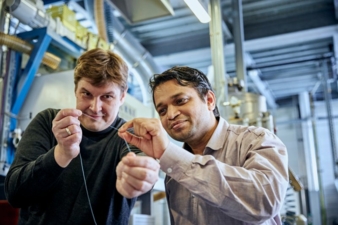19/03/2020 – Air – drive the change — auf Deutsch lesen
Make it fair, clean the air
Jeans often serve as the prime example of fashion’s negative effects on the planet. New technologies enable sustainable alternatives.
In early January, Fair Fashion Brands presented their environmentally conscious denims at the Neonyt trade fair in Berlin. Meanwhile, the Aachen Institute for Textile Technology has developed a fibre made from carbon dioxide that could in the future replace Lycra.
Conventional production of clothing has far-reaching negative global impacts on people and the environment.
According to environmental discussions, as much as 35 percent of global cotton output goes into the production of denim. A single kilogram of harvested cotton causes some 1.8kg of CO2 emissions, to say nothing of the huge volumes of water used. Conventional monoculture farming also requires large quantities of pesticides, as a consequence of which insects die and the soil is degraded. Unless adequate protection is provided, workers too will come into contact with these poisonous chemicals, both in the field and during the subsequent fabric washing and bleaching processes. And despite the 2004 ban, sandblasting is still widespread in jeans production, the quartz dust bringing with it extreme health risks to workers’ lungs.
The production of denim, then, is detrimental to the environment in many respects and produces greenhouse gas emissions all the way from the cotton fields to the factory, finishing plant and transportation. And yet there is another way, as the brand Armedangels, for example, has shown. Between 14 and 16 January 2020, the label presented its new collection at the Neonyt fair in Berlin. In its ‘Detox Denim’ line, the Cologne-based company has developed highly fashionable jeans that make no use of pesticides, heavy metals or chlorine. It works alongside GOTS-certified partners and starts with the raw materials themselves. “We all know by now that CO2 levels are the most important indicator of air quality and of global climate change, which is the biggest challenge of the 21st century,” explains Lavinia Muth, Corporate Responsibility Manager at Armedangels. “Organic cotton saves nearly 46 percent of CO2 emissions, improves the fertility of the soil and binds more CO2 into the soil.”
In the textile finishing process, Armedangels avoids the use of poisonous chlorine or harmful potassium permanganate and relies instead on green technologies such as laser finishing and ozone washing. In appearance, the effect is no different from conventional bleaching but according to the brand, lasering yields energy savings of up to 62 percent and savings in water of up to 67 percent. In conventional production, one pair of jeans uses between 1.5kg and 4kg of chemicals, though, and so far organic cotton has just a tiny market share – less than 1 percent.
New elastic CO2-based textile fibres
So, what is to be done with the large quantities of carbon dioxide that the fashion industry generates? Why not simply make clothes out of it and close the cycle, wondered Covestro, manufacturers of high-tech polymer materials. In collaboration with the Institute for Textile Technology (ITA) at RWTH Aachen University, the Leverkusen-based materials manufacturer used two research projects to successfully produce an elastic textile fibre based on CO2. This fibre can replace some of the mineral oil currently used in the production of synthetic fibres such as Lycra. Possible fields of application for the new fibre, called Cardyon, are in socks and medical textiles.
“The CO2-based material could before long provide a sustainable alternative to conventional elastic fibres,” explained Professor Thomas Gries, Director of the Institute for Textile Technology (ITA) at RWTH Aachen University. And it would achieve this with a smaller ecological footprint and without the use of environmentally harmful solvents. A process known as ‘melt spinning’, in which CO2-based thermoplastic polyurethane is fused, pressed into very fine fibres and then processed into a yarn of endless fibres, is what makes this possible. There are, though, two sticking points that need to be solved before the fibres can fully replace mineral oil as a raw material: the high production costs, and an adequate availability of green energy that the processes would require. In the ‘Textile Technology Talks’ presented during the Heimtextil trade fair from 7 to 10 January 2020 in Frankfurt am Main, Professor Gries offered some insights into the ITA’s new technologies and product developments. He expressed approval of a switch in the textile production chain from mineral oils to bio-products. With the aid of new technology, a paradigm shift in raw materials could put a more sustainable textile industry within reach – and in the longer term, ensure better air quality.
What to do with the large quantities of carbon dioxide that the fashion industry generates?
Turn it into clothes and close the circle!
It’s a problem that’s on everyone’s lips: conventional clothing production has a negative impact across the world, for people and for the environment. Dangerous chemicals, polluted groundwater and harmful working conditions in the textile industry regularly make the headlines. Approaches by industry to resolve these issues are currently under more intense discussion in the sector than almost any other topic. In this country, jeans are one of the most popular items of clothing – every German wardrobe contains on average eight pairs. According to Statista, about 197 mn pairs of jeans were imported into Germany between 2006 and 2018, originating primarily in Bangladesh, Pakistan and Turkey. This denim mountain has not only generated huge transport emissions but has also resulted in far-reaching effects in the producing countries.
Katharina Koch




